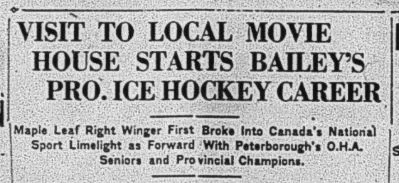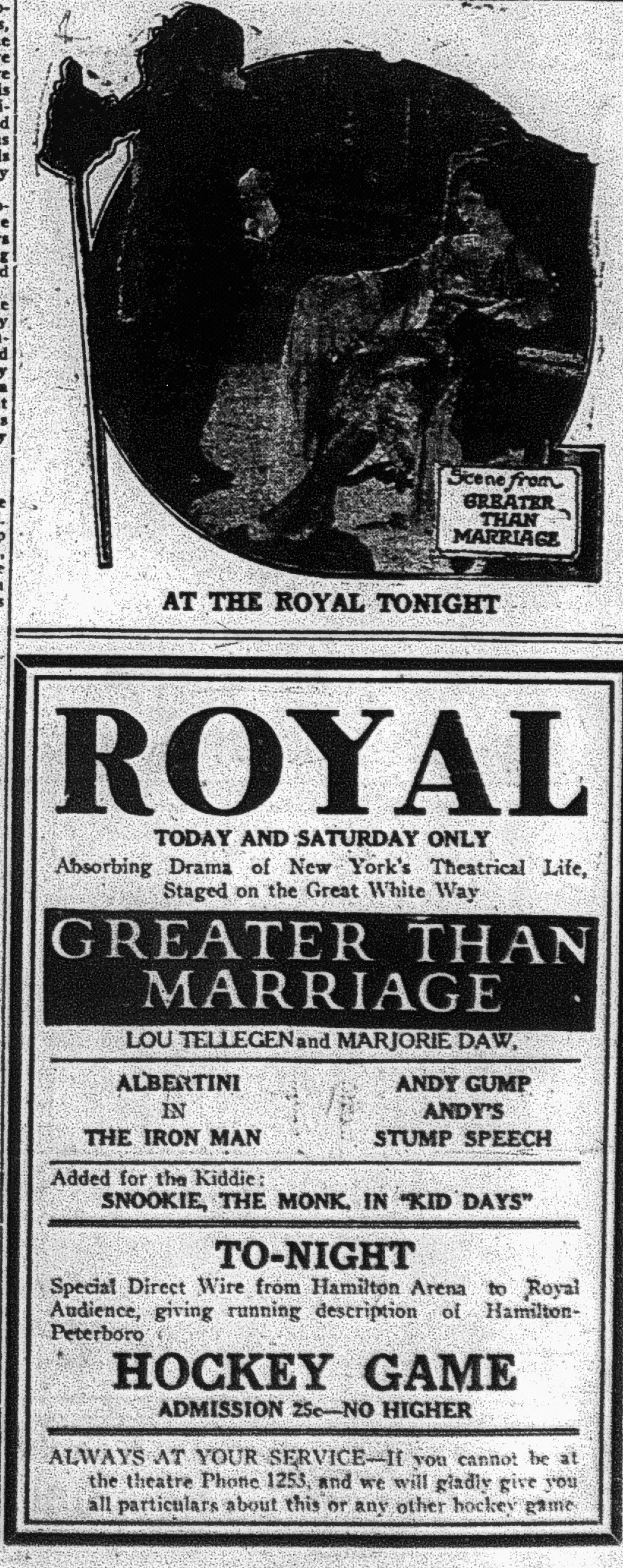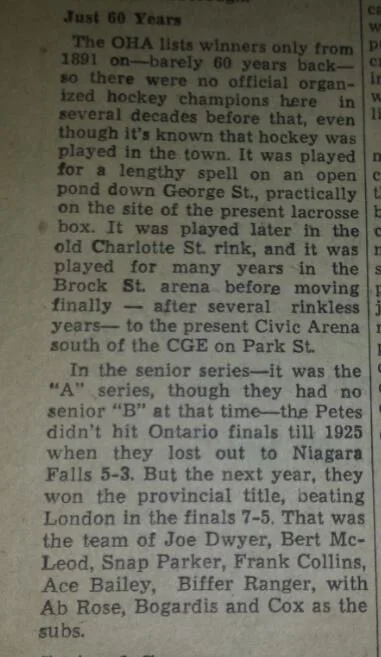Ace Bailey Goes to the Movies–and Gets a Pro Hockey Contract
Peterborough Evening Examiner, Nov. 24, 1930, p.9.
Examiner, Monday, March 8, 1926, p.11.
For a brief while in the 1920s in Peterborough, motion picture theatres and hockey were joined at the hip. In a hockey-crazy town, want to get the score of an out-of-town game? Go to the movies.
After all, a movie theatre can be a diversion and a charm, and full of possibilities – it is a place, perhaps, for the unusual to occur.
Who knows? Like Ace Bailey, you might even get yourself a major-league hockey contract.
For a couple of seasons (1924–25 and 1925–26) the Toronto Maple Leafs’ legendary Irvine “Ace” Bailey – the Bracebridge-born “speed artist” – played with the Peterborough Petes.
In his second season in the city Bailey scored nine goals in nine games, and the team won the provincial title. When he wasn’t playing hockey Bailey was working at the Peterborough Lock Manufacturing Company, a large locally owned business, and boarding with a Mrs. A. Lewis at 271 William St., a little side street between King and Bolivar in “the Avenues” area.
In Bailey’s time in Peterborough, the movie theatres did more than screen films. They also made much of announcing hockey scores.
Examiner, Feb. 13, 1925.
In February 1925 the Royal Theatre (which closed later that year) had its “absorbing” silent dramatic film Greater Than Marriage, plus other attractions, but it also offered fans a chance to get a “running description” of that night’s hockey game, which would have included the exploits of young Irvine Bailey (not yet known as “Ace”).
For a big playoff game at the end of the following season fans were invited out to Victoria Hall (formerly Bradburn’s Opera House) to catch the score. (And you could smoke all you like, too.) But others could also both watch a movie and get the results just down the road at the Grand Opera House, taken over (in expectations of vast crowds) by the smaller Regent Theatre.
Examiner, March 8, 1926, p.1.
Examiner, Monday, March 8, 1926, p.1.
Examiner, Jan. 21, 1926. Movies, music, and hockey scores.
A 1930 article in the Examiner (reprinted from the Toronto Telegram) tells the story of how Ace Bailey worked his way to a pro contract in the office of a Peterborough movie theatre.
The account, written when Bailey was in his prime, records that in Peterborough in 1926, “The front line of Ranger, Collins, and Bailey gave the fans many a thrill with their brilliant scoring plays.”
One night when the Peterborough team was playing at the Arena Gardens on Mutual Street in Toronto, Bailey had come down with a “very bad case of tonsillitis,” recalled Charles Querrie, the first general manager of the Toronto Maple Leafs – and who particularly noticed Bailey’s play that evening. “Against doctor’s orders, and club directors, he went out and, with his neck all bound up in bandages, played a whale of a game.”
“Hockey Played for Years on Pond Near Lacrosse Box Site,” Examiner, July 14, 1950, p.14. Bailey’s Peterborough hockey team.
By autumn 1926 the youngster had impressed watchful hockey minds enough to be approached by the Montreal Maroons, who offered a “first call” arrangement, which Bailey accepted. But Bailey was more interested in playing with the Toronto St. Pats (who would soon become the “Maple Leafs”). He had played both junior hockey and lacrosse in Toronto.
One Saturday that fall Bailey caught the afternoon train to the big city to meet with St. Pats team officials at a designated hotel. He waited and waited, but the reps never did show up. He caught the last train back to Peterborough; the “blind date” was enough to make him contemplate remaining an amateur.
Then, one evening shortly after his trip to Toronto, a friend came along to see him at his house and suggested they take in a movie. For some reason, perhaps to avoid being seen, Bailey agreed to go on condition that they take the “back way to the theatre.” Soon after they arrived, Bailey got a tap on the shoulder. Someone wanted to talk to him in private. It turned out that the house manager had been contacted and asked to locate “that Bailey man.”
Bailey was shown into the theatre office, where he soon found himself on the phone, talking to the owner of the St. Patrick’s club. Bailey gave the owner a figure he thought would be rejected – $2,000 – and to his surprise it was accepted. All he had to do was report to the hockey club in Toronto as soon as possible.
Bailey first of all phoned Eddie Gerard of the Montreal Maroons because he had given that team an option for first bid on his professional services. Gerard said the Maroons couldn’t come anywhere near the amount Toronto had offered and suggested that Bailey accept the Toronto offer. The article tells what happened next:
“Investing the sum of ten dollars Bailey visited a law office in Peterborough and had a contract drawn up with clauses scratched out here and there with enough insertions to make the document look like the famous peace treaty.
Ace Bailey, publicity photo for the 1933–34 season. Wikipedia Commons.
“The next scene is in the office of the Toronto St. Patrick’s Club with Bailey and the officials in attendance. On the table were two contracts, the one Bailey had brought himself and the other the club owners had prepared. The owner of the club didn’t care which one was signed as long as Bailey was secured for the St. Pats, and in his excitement Bailey signed the club’s own contract after spending a ten spot to prepare his own. It made little different, however, as both carried the same financial settlement.”
The official signing date was Nov. 3, 1926. Not long after that, in that same first season, the St. Pats, under new ownership, became the Toronto Maple Leafs. (By 1930, when the article was written, Bailey was one of only two remaining players – the famous Hap Day was the other – remaining from those turned over to the Leafs in the deal.) Bailey quickly became a star, winning the Art Ross Trophy for scoring in 1928–29.
“Always a fast skater and neat combination player,” according to the 1930 article, Bailey went on to a Hall of Fame career that was cut short in December 1933 by a devastating check from behind (leading to a skull fracture) delivered by Boston’s notorious Eddie Shore.
Notes
The article doesn’t mention which theatre. At the time Peterborough had only two movie theatres, the Capitol, seating 1,106, 306–8 George St. N., and the Regent, seating 595, at 139 Hunter St. E. (where Hobarts Steak House is today). I suspect they might have gone to the smaller Regent, because it would have been easier to slip into, maybe from the back, unnoticed. The article doesn’t mention whether Bailey and his friend stayed to take in the flick.
See also Charles Querrie, “To ‘Ace’ Bailey,” Examiner, Dec. 26, 1933, p.9. Querrie was at the contract negotiations and says the official Bailey talked to was no less than N.L. Nathanson, the “big noise” of St. Pats and a motion “picture magnate.” It might not be all that surprising that the contact with Bailey occurred in a movie theatre. Nathanson had purchased his first theatre in 1916 and had become president of Paramount’s Canadian subsidiary, Famous Players, dominating film distribution in Canada.









